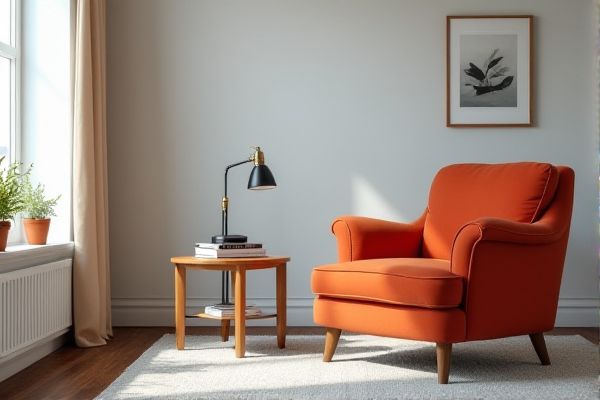
Accent chairs offer a stylish focal point with unique designs and vibrant colors, perfect for adding personality to any room, while armchairs prioritize comfort with padded seats and supportive armrests ideal for relaxation. Explore this article to discover which choice best complements your space and lifestyle.
Table of Comparison
| Feature | Accent Chair | Armchair |
|---|---|---|
| Purpose | Enhances room decor, adds style and color | Provides comfort and support for seating |
| Design | Bold, decorative, varied styles and colors | Usually cushioned, ergonomic, with armrests |
| Functionality | Primarily decorative | Primarily for comfortable seating |
| Armrests | May or may not have armrests | Always has armrests |
| Size | Compact, fits in small spaces | Larger, designed for relaxed seating |
| Common Usage | Living rooms, bedrooms, accents corners | Living rooms, offices, reading nooks |
Understanding the Difference: Accent Chair vs Armchair
An accent chair is primarily designed to enhance the aesthetic appeal of a room with unique styles, colors, and patterns, while an armchair emphasizes comfort and support with cushioned armrests and ergonomic design. Your choice depends on whether you prioritize visual interest or seating comfort in your living space. Both types serve distinct functions, making it essential to understand their differences for optimal furniture selection.
Defining Accent Chairs: Key Features
Accent chairs are designed to complement your existing furniture with unique styles, bold colors, and distinct shapes that add visual interest to a room. Key features include smaller dimensions compared to armchairs, decorative upholstery, and a focus on aesthetic appeal rather than maximum comfort or support. Unlike armchairs, which prioritize function and cushioning for extended seating, accent chairs serve as statement pieces that enhance the room's overall design.
Defining Armchairs: Key Features
Armchairs are characterized by their substantial structure, featuring fully upholstered seats, backs, and arms that provide optimal comfort and support. Typically designed with a higher backrest and cushioned armrests, they prioritize ergonomic seating for extended use. Unlike accent chairs, armchairs often serve as primary seating options in living rooms, emphasizing both functionality and durability.
Style and Aesthetic Comparison
Accent chairs showcase bold designs and vibrant colors that serve as statement pieces, enhancing your room's visual appeal with unique shapes and patterns. Armchairs prioritize comfort and traditional elegance, featuring plush cushioning and supportive armrests that blend seamlessly with classic or cozy interiors. Your choice depends on whether you want a standout decorative element or a functional, inviting seating option for relaxation.
Functionality and Use Cases
Accent chairs provide versatile seating options that enhance the aesthetic appeal of living spaces, often used for decorative purposes or occasional seating in bedrooms and lounges. Armchairs offer superior comfort and support with their padded armrests, making them ideal for reading nooks, home offices, or living rooms where extended sitting is common. Your choice depends on whether you prioritize style and flexibility or ergonomic functionality and daily use comfort.
Comfort and Ergonomics
Accent chairs prioritize style and often feature unique designs but may sacrifice ergonomic support and long-term comfort. Armchairs are typically built with more cushioning, broader armrests, and structured back support, enhancing comfort and promoting better posture during extended use. Your choice should consider how much time you plan to spend seated and whether ergonomic features are a priority for everyday relaxation.
Material and Construction Differences
Accent chairs often feature lightweight frames made from materials like wood, metal, or plastic, designed for aesthetic appeal and versatility, while armchairs typically prioritize sturdier construction with robust hardwood frames for enhanced durability and comfort. Upholstery materials in accent chairs may vary widely, including fabric, faux leather, or velvet, emphasizing style, whereas armchairs usually utilize thicker padding and premium fabrics or genuine leather to support prolonged use. Your choice depends on whether you prioritize decorative flair or substantial, long-lasting seating.
Placement Ideas: Where to Use Each Chair
Accent chairs fit perfectly in living rooms, bedrooms, or entryways, adding a pop of color and style while serving as occasional seating near coffee tables or reading nooks. Armchairs, with their supportive design, are ideal for cozy corners, home offices, or next to fireplaces, providing comfortable spots for relaxation or extended sitting. Placement of accent chairs often emphasizes aesthetics and contrast, whereas armchairs prioritize ergonomic comfort and functional seating.
Buying Guide: Which Chair Suits Your Space?
An accent chair is ideal for adding a pop of color or unique design to a room without compromising space, perfect for smaller areas or as a decorative piece. Armchairs offer more comfort with enclosed sides and are best suited for larger living spaces where relaxation and support are priorities. Evaluate room size, intended use, and style preferences when choosing between an accent chair and an armchair to ensure the perfect fit for your home.
Accent Chair vs Armchair: Pros and Cons
Accent chairs enhance room aesthetics with bold designs and vibrant colors, making them ideal for adding personality and style to your space, while armchairs prioritize comfort with sturdy armrests and cushioned seating, perfect for relaxation. Accent chairs are typically smaller and more lightweight, offering versatility in placement, whereas armchairs often require more space due to their bulkier design and substantial support. Your choice depends on whether you value visual appeal and design variety or ergonomic comfort and functionality in your seating.
 homyna.com
homyna.com